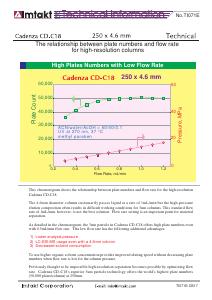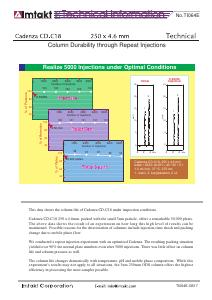Performance Column
High separation performance
Utility of 250mm length column
500x4.6mm, up to 100,000 theoretical plates in a single column
Isomer separation, multi-component separation




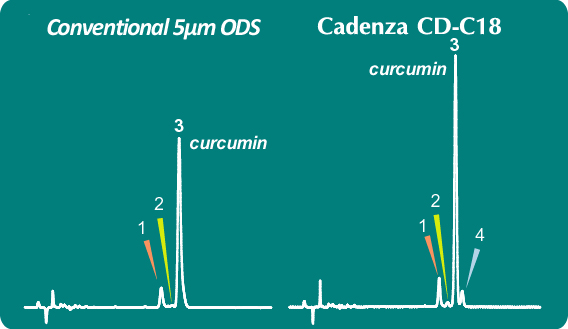
FEATURES
High Theoretical Plates Achievable with 3μm Particles, Difficult to Achieve with Sub-2μm Columns (Approximately 50,000 Plates at Shipment)
Improving Separation for Traditional 250x4.6mm Methods
Ideal for methods prioritizing separation, such as multi-component separations and isomer separations
Packing long columns with fine particle packing material is not easy. The longest columns packed with sub-2μm particles are generally 150mm, with theoretical plates around 30,000. Packing columns longer than this is quite difficult.
While theoretically, sub-2μm columns are considered higher performance than 3μm columns, this assumes manufacturing techniques are not taken into account. In practice, the number of theoretical plates and peak shape are significantly influenced by the packing technique (such as slurry composition and purging methods). Furthermore, the finer the particles, the more difficult the packing, leading to relatively lower column performance.
Additionally, finer particle columns are more expensive, and the stress on columns from ultra-high-pressure analysis decreases their durability, raising operational costs.
IMTAKT's 3μm packing material is designed for lower pressure compared to sub-2μm packing materials, making it advantageous for packing long columns. This has enabled the early establishment of packing techniques for 250-500mm long columns. This allows for the stable supply of Performance columns, with approximately 50,000 plates for 250x4.6mm and up to 100,000 plates for 500x4.6mm columns at the time of shipment.
Separation with Sub-2μm Columns Does Not Always Improve Significantly (TI709E)
As shown in figure (TI709E), the theoretical plates of a 1.7μm column in isocratic analysis are about 1.5 times those of an IMTAKT 3μm column, not reaching the theoretical value of 1.8 times. A notable characteristic is that the separation peaks exhibit slight tailing, resulting in minimal difference in separation efficiency. On the other hand, the column pressure shows more than double the difference. If there is little difference in separation, choosing a 3μm column might be more practical to avoid high-pressure HPLC equipment troubles.
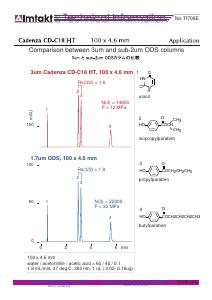
Sub-2μm columns don't always achieve proportional theoretical plates (TI708E)
The number of theoretical plates of a column is inversely proportional to the particle size. Theoretically, a 1.7μm column should exhibit 1.8 times the theoretical plates of a 3μm column. In figure (TI708E), a comparison between a 100mm long 1.7μm column and a 150mm long 3μm column (1.5 times longer) is shown. Contrary to theoretical expectations, IMTAKT’s 3μm column shows higher performance. Both separation efficiency and column pressure favor the 3μm column. Therefore, the idea that “the higher the column pressure, the better the separation performance” is not always correct.
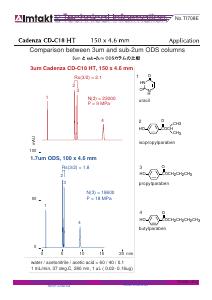
Performance Comparison IMTAKT 3μm Columns vs. Other 1.7μm Columns (TI707E)
When setting the flow rate of a 1.5 times longer 3μm column to 1.5 times that of a 1.7μm column, the analysis time remains approximately the same. As shown in figure (TI707E), retention is similar, and the 3μm column has advantages in theoretical plates, separation efficiency, and pressure. This result is consistent even when the analysis flow rate is changed. For improving separation, using a long column such as a 250mm one with 3μm particles is more practical than simply reducing particle size to sub-2μm.
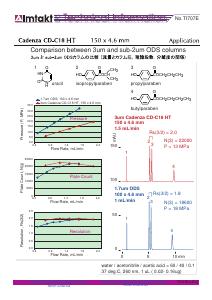
Relationship Between Flow Rate, Pressure, and Theoretical Plate Number of
250x4.6mm High Theoretical Plate Columns (TI071E)
Repeated Injection Durability of 250x4.6mm High Theoretical Plate Columns (TI064E)
Utility of 250mm Columns: Improving Short Column Separations
This is a low-pressure, high-load capacity preparative column using 5μm particles.
Utility of 250mm Columns: Improving Separation of Traditional 5μm Columns
When improving the separation of traditionally used 250x4.6mm 5μm columns, 3μm columns of the same size are effective.
